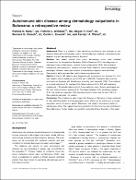| dc.identifier.citation | Madu, P. N., Williams, V. L., Noe, M. H., Omech, B. G., Kovarik, C. L., & Wanat, K. A. (2019). Autoimmune skin disease among dermatology outpatients in Botswana: a retrospective review. International journal of dermatology, 58(1), 50-53. | en_US |
| dc.description.abstract | Background There is a paucity of data describing autoimmune skin diseases in sub-
Saharan Africa and in HIV positive cohorts. We describe the incidence of autoimmune skin
diseases in public dermatology clinics in Botswana.
Methods New patient records from public dermatology clinics were reviewed
retrospectively for the period of September 2008 to December 2015. New diagnoses of
cutaneous lupus erythematosus, systemic lupus erythematosus (SLE) with cutaneous
involvement, dermatomyositis, systemic sclerosis, lichen sclerosus, bullous pemphigoid,
pemphigus foliaceus, pemphigus vulgaris, and pemphigus vegetans were identified.
Demographic data were recorded, and incidence was determined.
Results A total of 262 patients were diagnosed with autoimmune skin disease (4% of all
new patients) with an incidence rate of 28.8 (per 1,000,000). Cutaneous lupus was the
most common diagnosis with discoid lupus occurring most frequently (12.6). The incidence
of systemic sclerosis (2.2), morphea (1.6), lichen sclerosus (1.5), SLE with cutaneous
involvement (1.3) and dermatomyositis (1.2) was relatively lower. Bullous pemphigoid was
the most common bullous disease (3.8). Pemphigus foliaceus (0.9), pemphigus vulgaris
(0.6), and pemphigus vegetans (0.2) were observed at a lower rate. At least 19.8% of
these patients were also HIV positive.
Conclusions The incidence of autoimmune skin diseases in Botswana is lower compared
to other published studies in other geographic areas, which may be reflective of a younger
population, barriers to access, genetic differences, and a lack of comparative studies in
sub-Saharan Africa. The hygiene hypothesis and helminth infections may also contribute to
these differences. Further studies are needed to understand these disorders in this region | en_US |

